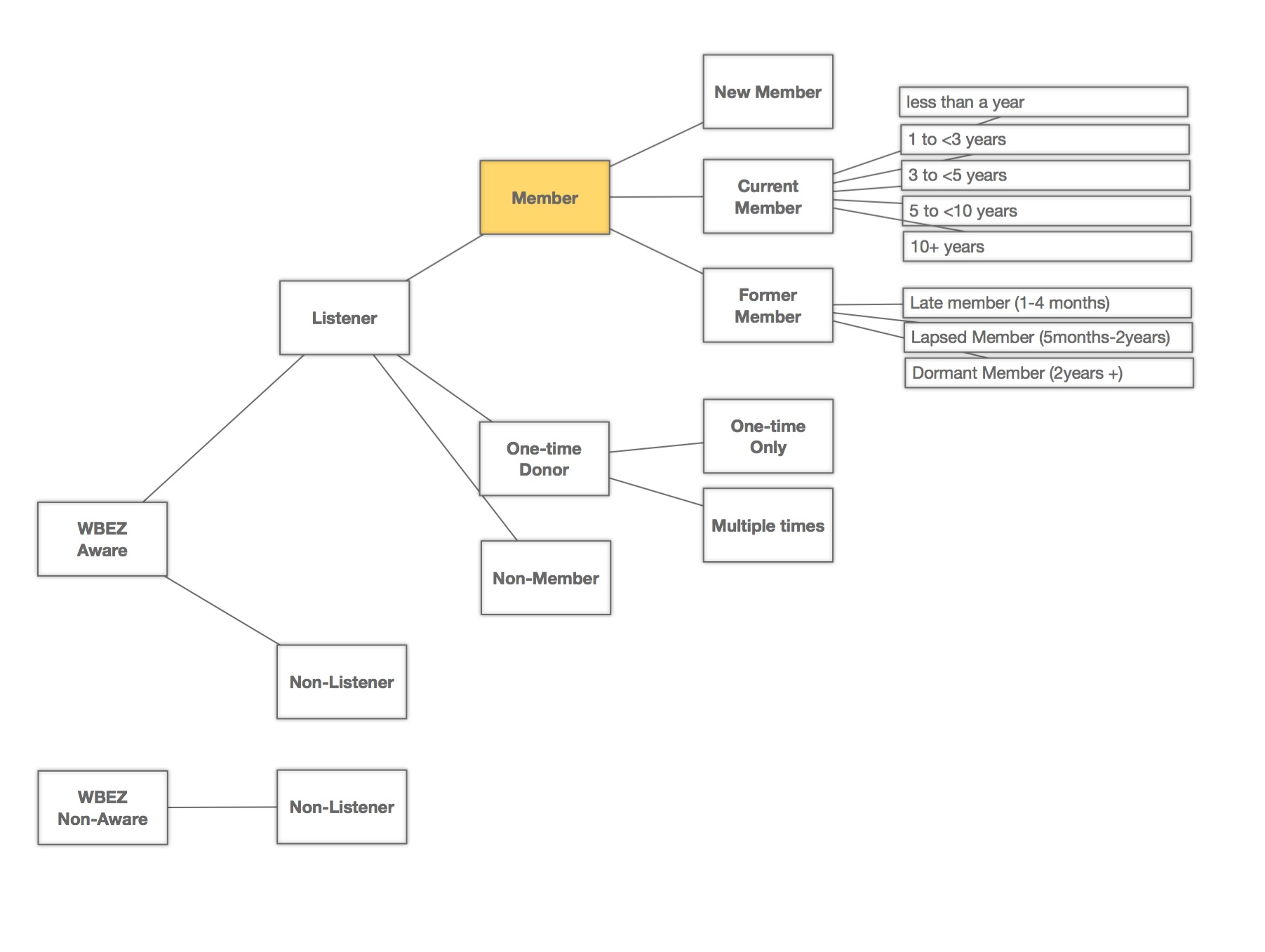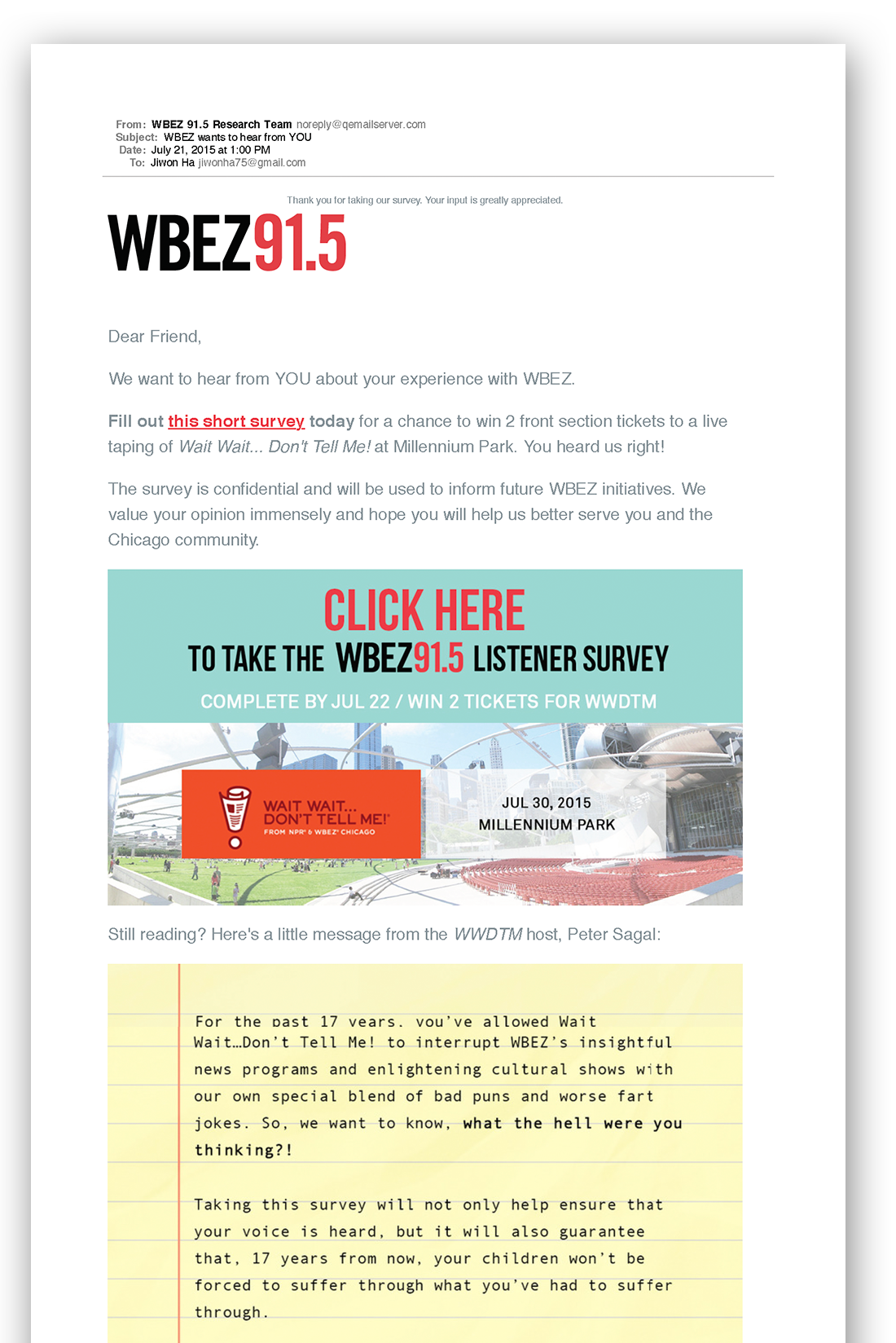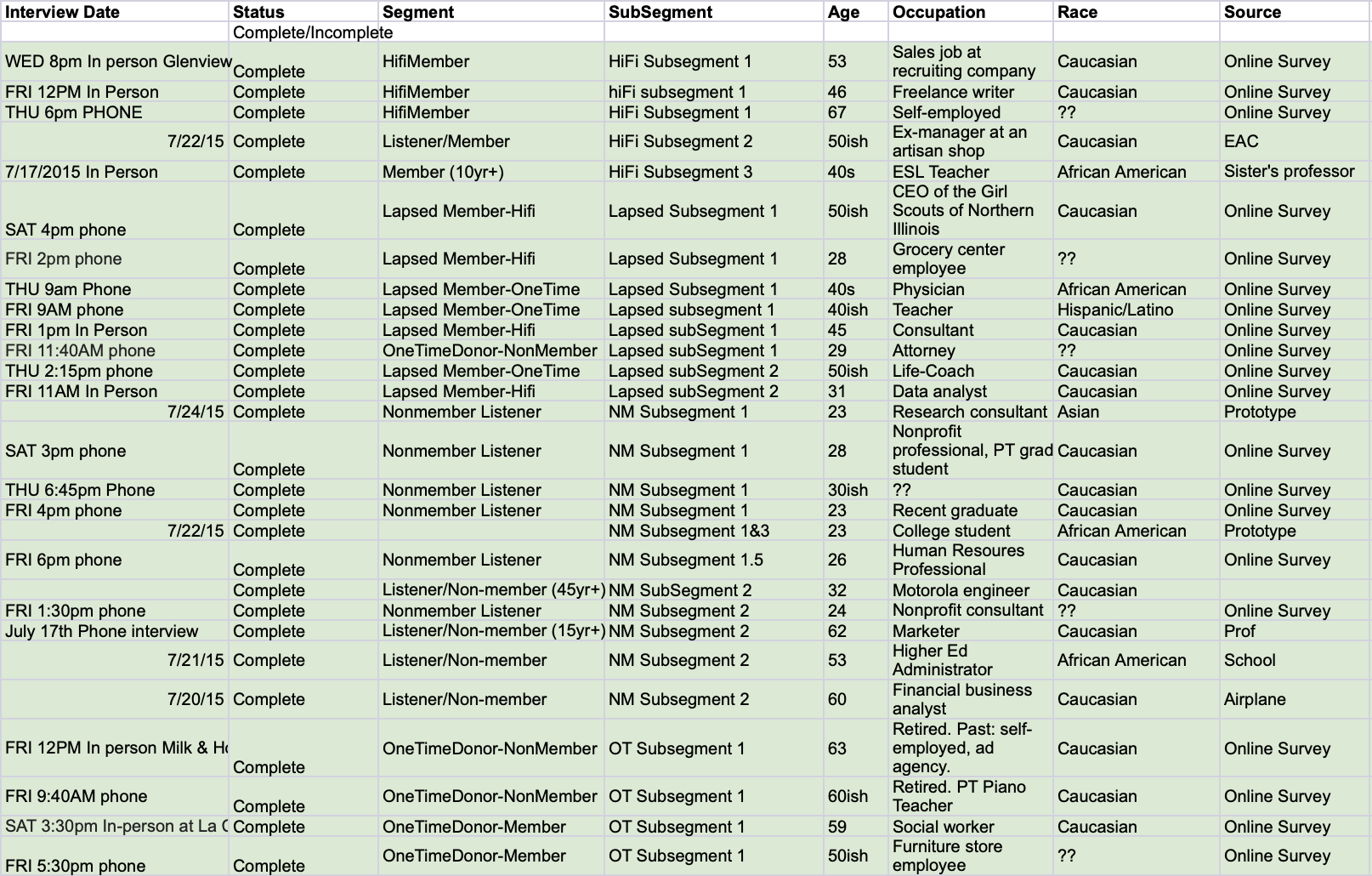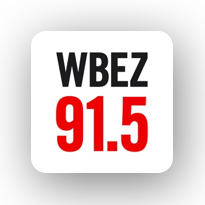Chicago's beloved public radio station, WBEZ, is well known for its national hits like "This American Life," "Wait Wait... Don't Tell Me!" and "Serial." While growing more popular than ever, the station was struggling with stagnant membership.
ROLE
Assigned to the Marketing and Membership Department, I worked with 4 other graduate interns to plan and execute an extensive consumer research on 1000+ listeners.
Survey design | Market research | Business strategy |
Quantitative research | Qualitative research | In-person consumer interview
CLIENT
Chicago Public Media
TEAM
YEAR
Summer 2015
CHALLENGES
Just like all other public media, WBEZ depends heavily on public donations. While they had a handful of donors who were making big annual contributions, the number of those who made monthly contributions was falling.
GOALS
To understand what hinders listeners from becoming members (donors)
APPROACH
Under the supervision of Prof. Tom Collinger and Prof. Judy Frank from Northwestern IMC Graduate program, the team was to undertake a consumer-centric and data-driven approach to solve the given challenge.
STEP 1
Interview internal stakeholders
Before rushing into brainstorming all the possible solutions, we believed getting as much context as possible about the problem was crucial to find a truly effective solution. While the given challenge was specific to the Membership department, we conducted 13 internal interviews across multiple departments (Editorial, Marketing/Membership, Finance, Philanthropy) to obtain a better understanding of WBEZ's organizational structure and how the functions of each internal team intersect with membership. Here are some of the key findings from the internal interviews.

Pledge drives hurt listenership, but no one complains
Based on streaming volume declines and Nielsen ratings drops, it is evident that pledge drives cause a temporary decrease in listenership; however, WBEZ almost never receives complaints regarding the pledge drive. The listeners understand the need for public radio stations to utilize pledge drives to meet revenue goals. They eventually come back to the station after the pledge drive ends.

One-time donors are not repeat givers
According to internal figures, two thirds of one-time donors never give again, and only about one third of them make a second one-time donation. This shows that while WBEZ hopes to foster a system where donors make regular contributions as members, this kind of relationship may not be the goal for all listeners. This insight suggests that members and one-time donors may perceive the act of donating to WBEZ very differently.

Members want to be talked to directly
When asking for donations, members respond best to personal messages asking the (“We need YOU”), as opposed to messages that (“We need to raise X amount of money”). This fact suggests that members are more responsive to direct and purposeful communications when being asked to donate to WBEZ.
STEP 2
Find knowledge gaps
One of the most helpful resources available to us was the past studies of WBEZ membership performance, because these reports provided an overview into WBEZ listener segments and their attributes. For the major reports like the 2014 Kannon market research and the 2008 Slover Linett membership research, we took time to digest and write preliminary analysis regarding the implications of the report data on our project focus.
More than anything, these existing reports helped us identify knowledge gaps and build hypothesis to validate. Many reports extensively scrutinized why, where, when, and how the listeners listen to WBEZ. We noticed, however, that none of the reports examined the relationship between the action of listening and the action of donating.
What we knew
- Only one out 10 listeners donate to WBEZ. Member to listener ratio is roughly 12% (Kannon, 2014).
- Past studies suggested that many members gave for emotional reasons such as a sense of responsibility. However the pledge drive tends to stress transactional reasons for becoming a member (e.g. making a donation in order to be entered into a raffle).
- Demographic attributes of WBEZ listeners: liberal, educated, of high income, female majority.
What we do not know
- In 2015, WBEZ was estimated to have 550K listeners, and only 14% or those were members. Why weren't all listeners become members/donors?
- If one was a member, why has he/she chosen to be a member?
- If one was NOT a member, why has he/she chosen NOT to be a member?
Knowledge gaps
- No research analyzed listeners based on their donation behavior. All the past studies segmented listeners based on how much/often they listen, not by how much/often they donate.
- No research analyzed the motivation/demotivation behind different donation behaviors.
STEP 3
Identify segments based on donation behavior
Once we realized our opportunity, the first thing we did was to request an access to the membership database. The membership database revealed how much/often members choose to donate and when they join or/and leave. Depending on their donation behavior, listeners could be categorized into different segments. See below for the detailed segment map.

Still, the questions remained as we did not know what made these segments exhibit different donation behavior. All segments under Listener were worth investigating. The Member segment would reveal the motivations behind why people would donate, while the One-Time Donor (or Lapsed Member) segment and the Non-Member segment would give us an insight into why people would not donate.
STEP 4
Collect quantitative data by conducting an online survey

The most effective way to learn why people behave in the way people do is to ask them directly, which was why we decided to run an email survey to everyone in the WBEZ listener database.
The main goal of the email survey were to identify the motivations and detractors of listeners to become or remain members. The motivational data gathered by the survey would allow us see the full picture when combined with the behavioral data from the membership database. Lastly, we hoped to farm potential interviewees for 1:1 in-person interview from the survey participants.
The email survey was sent out to everyone in the WBEZ listenership database which was about 10,000 people. Thanks to the generosity of the Wait Wait... Don't Tell Me team, we could offer the two tickets to the live taping of Wait Wait... Don't Tell Me as a prize, which was probably why we got over 1400 responses.
Designing a survey was one of the most challenging parts of this project. The survey consisted of the following three parts:
- Screening questions
- Segment-specific questions
- Universal questions
Screening questions were to determine what kind of listener one was and under which segment he/she fell (non-member listener vs member vs one-time donor vs lapsed member). Depending on the segment type, participants would get a different set of questions asking why they donate, do not donate, stopped donating, or donated only once. Then there was a set of universal questions on a variety of topics from listening habits, content preference, and general lifestyle.
The survey went through a number of painstaking reviews by the team members, the directors of the WBEZ Marketing/Membership department, as well as the Northwestern IMC faculty members. We also ran a couple user testings of the survey to reduce any confusion in wording and answer options.
We used Qualtrics to host the email survey, which allowed us to generate an individual URL link for each email. This was a crucial add-on because it expedited the process of merging the survey results with the existing membership data at a later stage of the project.
STEP 5
Collect qualitative data by interviewing the listeners
At the end of the email survey, we asked participants if they would be willing to meet us in person. Among those who expressed interest, we randomly picked 32 people (8 people from each segment) and conducted interviews with each of them over the course of two weeks. We drafted the interview guide and questions together to ensure we collect consistent data from interviewees. Documentation was also a huge part of this step as we transcribed all the interviews.

STEP 6
Analyze and synthesize the collected data
For the quantitative data, we successfully merged the membership database with the survey results. We crosschecked the two data sets and made sure each participant had identified himself/herself as a correct segment. Then we analyzed survey results for each question looking for contrast between segments.
For the qualitative data, five of us reviewed all 32 interview transcripts together, looking for repeating themes, keywords, patterns, and sentiments. Then we examined how these qualitative findings could explain or tie back to the patterns we had found from quantitative data. See below for some key findings for each segment.
Non-Member Listener
- Young Millennials
- For this segment, the biggest barrier to membership was "Economic Situation."
- However, 90% answered they were a paid subscriber/donor to one or more media channels.
- They showed a strong interest in attending WBEZ live events. This segment wanted opportunities to engage with the station and to give their time.
- They felt excluded from membership
Lapsed Member
- The main reasons this segment had left WBEZ membership were: due to their economic situation (50%), because they chose to donate to other charities instead (45%), and because they haven't gotten around it (25%).
- 25% expressed their interest in coming back to the membership.
One-Time Donor
- 66% of the One-Time Donors who gave more than $120 per year preferred manual donations.
- 25% of the segment did not know he/she was a WBEZ member.
All segments shared a strong affinity towards WBEZ and/or public radio. However, one key observation from the in-person interviews was that listeners from all segments felt that their "small" donations did/would not matter much to the station.
“[my] contribution was not acknowledged, I am not a member, I received one note that I was a member but in everything else I received I was not a member. So the money was apparently meaningless in the overall scheme of things. ”
STEP 7
Pull the key insights
Donors lapse due to feeling underappreciated by and disconnected with the station
Finding from our research revealed a couple phenomena. First, the "free riders," the non-member listeners, are mainly consisted of young millennials who claimed that they could not afford monthly donations to WBEZ. However, they were willing to engage with and support the station by other means. They might be penniless but they sure loved the station.
The other interesting trend we unveiled was the sense of triviality shared among the current members as well as the lapsed members. Many felt that their contributions went unnoticed and underappreciated. In fact, many lapsed members sited it as a main reason why they left the membership.
As our final goal was to come up with strategic recommendations to increase the membership revenue, we concluded there was more potential in retention than acquisition and focused on the second learning for the final presentation.
FINAL RESULT
The team presented the research findings and strategic recommendations to the CEO of Chicago Public Media.
Build reciprocity
In order to retain members, the key would be to make them feel appreciated. We recommended the launch of donor appreciation initiatives that would make the Thank You feel personal. We emphasized that it was a proven tactic with a case study of KPCC, Southern California Public Radio. KPCC randomly picks 5 individual donors every month to make thank you calls. This low-cost initiatives had received a lot of positive feedback from their donors and had improved KPCC's retention rate.
Communicate the impact
"Betterment of others" was found to be one of the main drivers for donation among the WBEZ listeners. Also, 60% of the members answered that they wanted to hear about the impact of their donations. In fact, clear and concrete impact messaging was a proven best practice for many nonprofit organizations. Following up with actual changes made possible by members' donations on a regular basis would definitely enhance the the membership experience and would help the members feel that their donations did matter.
Strengthen the loyalty
This recommendation was specifically for the Millennials, the Penniless Lovers in our words. While this group would not generate any revenue for a while, they definitely has a potential to be loyal members in the near future. In the meantime, the station could exploit their loyalty in different ways. KWMU, St.Louis Public Radio, for instance, ran a program called Young Friends (now Generation Listen) to engage younger listeners.
Due to high demand, we opened our final presentation to everyone, and people across different departments at WBEZ came to the presentation. The presentation received overwhelmingly positive reaction and started a very passionate discussion among attendees. Goli Sheikholeslami, the WBEZ CEO at the time, asked us to present the findings again at the board meeting. The board was very pleased with our approach and findings, urging the Membership department to look into the launch of a donor appreciation initiative.
© Jiwon Ha. 2021. ALL RIGHTS RESERVED
